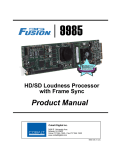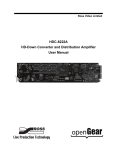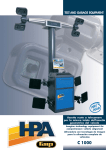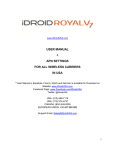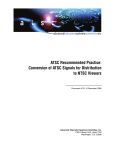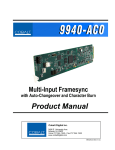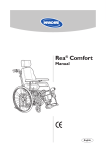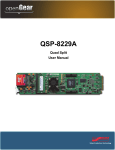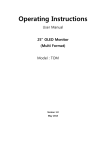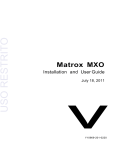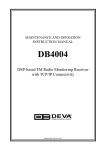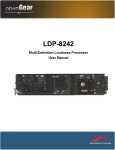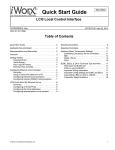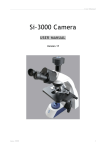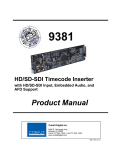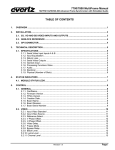Download HDC-8223 User Manual
Transcript
HDC-8223 HD-Down Converter and Distribution Amplifier User Manual Thank you for choosing Ross You've made a great choice. We expect you will be very happy with your purchase of Ross Technology. Our mission is to: 1. Provide a Superior Customer Experience • offer the best product quality and support 2. Make Cool Practical Technology • develop great products that customers love Ross has become well known for the Ross Video Code of Ethics. It guides our interactions and empowers our employees. I hope you enjoy reading it below. If anything at all with your Ross experience does not live up to your expectations be sure to reach out to us at [email protected]. David Ross CEO, Ross Video [email protected] Ross Video Code of Ethics Any company is the sum total of the people that make things happen. At Ross, our employees are a special group. Our employees truly care about doing a great job and delivering a high quality customer experience every day. This code of ethics hangs on the wall of all Ross Video locations to guide our behavior: 1. We will always act in our customers’ best interest. 2. We will do our best to understand our customers’ requirements. 3. We will not ship crap. 4. We will be great to work with. 5. We will do something extra for our customers, as an apology, when something big goes wrong and it's our fault. 6. We will keep our promises. 7. We will treat the competition with respect. 8. We will cooperate with and help other friendly companies. 9. We will go above and beyond in times of crisis. If there's no one to authorize the required action in times of company or customer crisis - do what you know in your heart is right. (You may rent helicopters if necessary.) HDC-8223 User Manual • Ross Part Number: 8223DR-004-01 • Release Date: February 27, 2014. Copyright © 2014 Ross Video Limited. Ross®, openGear®, and any related marks are trademarks or registered trademarks of Ross Video Ltd. All other trademarks are the property of their respective companies. PATENTS ISSUED and PENDING. All rights reserved. No part of this publication may be reproduced, stored in a retrieval system, or transmitted in any form or by any means, mechanical, photocopying, recording or otherwise, without the prior written permission of Ross Video. While every precaution has been taken in the preparation of this document, Ross Video assumes no responsibility for errors or omissions. Neither is any liability assumed for damages resulting from the use of the information contained herein. Patents Patent numbers 4,205,346; 5,115,314; 5,280,346; 5,561,404; 7,034,886; 7,508,455; 7,602,446; 7,834,886; 7,914,332; 8,499,019 B2; 2039277; 1237518; 1127289 and other patents pending. Important Regulatory and Safety Notices to Service Personnel Before using this product and nay associated equipment, refer to the “Important Safety Instructions” listed below to avoid personnel injury and to prevent product damage. Product may require specific equipment, and/or installation procedures to be carried out to satisfy certain regulatory compliance requirements. Notices have been included in this publication to call attention to these specific requirements. Symbol Meanings This symbol on the equipment refers you to important operating and maintenance (servicing) instructions within the Product Manual Documentation. Failure to heed this information may present a major risk of damage to persons or equipment. Warning — The symbol with the word “Warning” within the equipment manual indicates a potentially hazardous situation, which, if not avoided, could result in death or serious injury. Caution — The symbol with the word “Caution” within the equipment manual indicates a potentially hazardous situation, which, if not avoided, may result in minor or moderate injury. It may also be used to alert against unsafe practices. Notice — The symbol with the word “Notice” within the equipment manual indicates a potentially hazardous situation, which, if not avoided, may result in major or minor equipment damage or a situation which could place the equipment in a non-compliant operating state. ESD Susceptibility — This symbol is used to alert the user that an electrical or electronic device or assembly is susceptible to damage from an ESD event. Important Safety Instructions Caution — This product is intended to be a component product of the DFR-8300 and OG3-FR series frames. Refer to the DFR-8300 and OG3-FR Series Frame User Manual for important safety instructions regarding the proper installation and safe operation of the frame as well as its component products. Warning — Certain parts of this equipment namely the power supply area still present a safety hazard, with the power switch in the OFF position. To avoid electrical shock, disconnect all A/C power cords from the chassis’ rear appliance connectors before servicing this area. Warning — Service barriers within this product are intended to protect the operator and service personnel from hazardous voltages. For continued safety, replace all barriers after any servicing. This product contains safety critical parts, which if incorrectly replaced may present a risk of fire or electrical shock. Components contained with the product’s power supplies and power supply area, are not intended to be customer serviced and should be returned to the factory for repair. To reduce the risk of fire, replacement fuses must be the same time and rating. Only use attachments/accessories specified by the manufacturer. EMC Notices United States of America FCC Part 15 This equipment has been tested and found to comply with the limits for a class A Digital device, pursuant to part 15 of the FCC Rules. These limits are designed to provide reasonable protection against harmful interference when the equipment is operated in a commercial environment. This equipment generates, uses, and can radiate radio frequency energy and, if not installed and used in accordance with the instruction manual, may cause harmful interference to radio communications. Operation of this equipment in a residential area is likely to cause harmful interference in which case the user will be required to correct the interference at their own expense. Notice — Changes or modifications to this equipment not expressly approved by Ross Video Limited could void the user’s authority to operate this equipment. CANADA This Class “A” digital apparatus complies with Canadian ICES-003. Cet appariel numerique de la classe “A” est conforme a la norme NMB-003 du Canada. EUROPE This equipment is in compliance with the essential requirements and other relevant provisions of CE Directive 93/68/EEC. INTERNATIONAL This equipment has been tested to CISPR 22:1997 along with amendments A1:2000 and A2:2002, and found to comply with the limits for a Class A Digital device. Notice — This is a Class A product. In domestic environments, this product may cause radio interference, in which case the user may have to take adequate measures. Maintenance/User Serviceable Parts Routine maintenance to this openGear product is not required. This product contains no user serviceable parts. If the module does not appear to be working properly, please contact Technical Support using the numbers listed under the “Contact Us” section on the last page of this manual. All openGear products are covered by a generous 5-year warranty and will be repaired without charge for materials or labor within this period. See the “Warranty and Repair Policy” section in this manual for details. Environmental Information The equipment that you purchased required the extraction and use of natural resources for its production. It may contain hazardous substances that could impact health and the environment. To avoid the potential release of those substances into the environment and to diminish the need for the extraction of natural resources, Ross Video encourages you to use the appropriate take-back systems. These systems will reuse or recycle most of the materials from your end-of-life equipment in an environmentally friendly and health conscious manner. The crossed out wheelie bin symbol invites you to use these systems. If you need more information on the collection, reuse, and recycling systems, please contact your local or regional waste administration. You can also contact Ross Video for more information on the environmental performance of our products. Company Address Ross Video Limited Ross Video Incorporated 8 John Street P.O. Box 880 Iroquois, Ontario, K0E 1K0 Ogdensburg, New York Canada USA 13669-0880 General Business Office: (+1) 613 • 652 • 4886 Fax: (+1) 613 • 652 • 4425 Technical Support: (+1) 613 • 652 • 4886 After Hours Emergency: (+1) 613 • 349 • 0006 E-mail (Technical Support): [email protected] E-mail (General Information): [email protected] Website: http://www.rossvideo.com Contents Introduction 1 Overview.............................................................................................................................. 1-2 Video Subsystem Overview................................................................................................. 1-3 Rear Modules......................................................................................................... 1-3 Input Select............................................................................................................ 1-3 Video Processor..................................................................................................... 1-3 Scaler Function...................................................................................................... 1-3 Closed Captioning Processor................................................................................. 1-3 Timecode Processor............................................................................................... 1-4 Audio Overview................................................................................................................... 1-5 Audio Down Mix Function ................................................................................... 1-5 Simplified Block Diagrams ................................................................................................. 1-6 R2-8223 Overview ................................................................................................ 1-6 R2C-8223 Rear Module ........................................................................................ 1-7 Documentation Terms and Conventions.............................................................................. 1-8 Installation 2 Before You Begin ................................................................................................................ 2-2 Static Discharge..................................................................................................... 2-2 Unpacking.............................................................................................................. 2-2 Installing the HDC-8223...................................................................................................... 2-3 Rear Modules for the HDC-8223 .......................................................................... 2-3 Installing a Rear Module ....................................................................................... 2-3 Installing the HDC-8223 ....................................................................................... 2-4 Cabling for the HDC-8223 .................................................................................................. 2-5 Audio Cabling ....................................................................................................... 2-6 User Controls 3 Control and Monitoring Features......................................................................................... 3-2 Status LEDs ........................................................................................................... 3-2 Operation 4 Control and Display Descriptions........................................................................................ 4-2 Function Submenu/Parameter Submenu Overview............................................... 4-2 Using DashBoard ................................................................................................................. 4-3 Ancillary Data Line Number Locations and Ranges ........................................................... 4-4 Timecode ............................................................................................................................. 4-6 Examples Cases A, B ............................................................................................ 4-6 Example Case C .................................................................................................... 4-7 Closed Captioning................................................................................................................ 4-8 Troubleshooting..................................................................................................... 4-8 Reticules............................................................................................................................... 4-9 Overview ............................................................................................................... 4-9 Output Audio Routing Controls......................................................................................... 4-10 HDC-8223 User Manual (Iss. 01) Contents • i Firmware Upgrades............................................................................................................ 4-12 Firmware Upgrade Controls ................................................................................ 4-12 Operational Notes............................................................................................................... 4-13 Video Payload ID ................................................................................................ 4-13 Scaler ................................................................................................................... 4-13 DashBoard Menus 5 Status Tabs ........................................................................................................................... 5-2 Status Tab .............................................................................................................. 5-2 Product Info Tab .................................................................................................... 5-2 Input Video Tab ................................................................................................................... 5-3 Output Video Tab................................................................................................................. 5-4 Output Routing Tab ............................................................................................... 5-4 Analog Video Tab.................................................................................................. 5-4 Scaler Tab............................................................................................................................. 5-5 Video Alignment Tab........................................................................................................... 5-6 Timecode Tab....................................................................................................................... 5-7 Video Payload ID Tab........................................................................................................ 5-10 Proc Control Tab ................................................................................................................ 5-11 Closed Captioning Tab....................................................................................................... 5-12 Reticules Tabs .................................................................................................................... 5-13 Basic Tab ............................................................................................................. 5-13 Advanced Tab ...................................................................................................... 5-14 Output Audio Routing/Controls Tab.................................................................................. 5-15 Embedded Output Tab ......................................................................................... 5-15 Analog Output Tab .............................................................................................. 5-15 Downmixer Tab ................................................................................................... 5-16 Audio Delay Tab.................................................................................................. 5-16 Presets/Firmware Upgrade Tab.......................................................................................... 5-17 Log Status Tab ................................................................................................................... 5-18 Troubleshooting 6 Error and Failure Indicator Overview .................................................................................. 6-2 DashBoard Status/Error Indicators and Displays................................................................. 6-3 Basic Troubleshooting Checks............................................................................................. 6-4 Processing Error Troubleshooting........................................................................................ 6-5 Troubleshooting Network/Remote Control Errors............................................................... 6-6 Specifications 7 Technical Specifications ...................................................................................................... 7-2 Service Information 8 Troubleshooting Checklist ................................................................................................... 8-2 Warranty and Repair Policy ................................................................................................. 8-3 ii • Contents HDC-8223 User Manual (Iss. 01) Introduction In This Chapter This chapter contains the following sections: • Overview • Video Subsystem Overview • Audio Overview • Simplified Block Diagrams • Documentation Terms and Conventions A Word of Thanks Congratulations on choosing an openGear HDC-8223 HD Down Converter and Distribution Amplifier. Your HDC-8223 is part of a full line of products within the openGear Terminal Equipment family of products, backed by Ross Video's experience in engineering and design expertise since 1974. You will be pleased at how easily your new HDC-8223 fits into your overall working environment. Equally pleasing is the product quality, reliability and functionality. Thank you for joining the group of worldwide satisfied Ross Video customers! Should you have a question pertaining to the installation or operation of your HDC-8223, please contact us at the numbers listed on the back cover of this manual. Our technical support staff is always available for consultation, training, or service. HDC-8223 User Manual (Iss. 01) Introduction • 1–1 Overview The HDC-8223 is a monitoring quality down-converter that also offers optional audio support. The down-converted SDI and analog composite signals are selected through four, 2:1 crosspoints allowing any combination of SD-SDI or analog composite (CVBS) outputs on the four card processed video outputs. With the R2C-8223 full rear module, four analog audio channels are available. The HDC-8223 also provides ARC processing and timecode/closed-captioning conversion from packet-based timecode formats and CEA608/708 HD formats to SD VITC-based (waveform) timecode and line 21 closed captioning (available on both SDI and analog video outputs). The HDC-8223 provides the following inputs and outputs: • HD/SD SDI IN A / SDI IN B – two dual-rate HD/SD-SDI inputs (GUI-selectable or basic failover) 1–2 • Introduction • PROCESSED VIDEO OUT (1-4) – via four independent 2:1 GUI-selectable crosspoints, each of the four BNC outputs can independently be set as SD-SDI or analog composite (CVBS) outputs • RLCK OUT (1-4) – four HD/SD-SDI reclocked buffered video outputs • AN-AUD OUT (1-4) – four balanced analog audio outputs (R2C-8223 rear module only) HDC-8223 User Manual (Iss. 01) Video Subsystem Overview The HDC-8223 features a downconverting scaler, video proc, and user-adjustable aspect ratio control and zoom control. The HDC-8223 video subsystem also provides the functions described below. Rear Modules The HDC-8223 physically interfaces to system video connections at the rear of its frame using a rear module. All inputs and outputs shown in Figure 1.3 enter and exit the card via the card edge backplane connector. The rear module breaks out the HDC-8223 card edge connections to BNC and other connections that interface with other components and systems in the signal chain. For More Information on... • the required rear modules, refer to the section “Rear Modules for the HDC-8223” on page 2-3. Input Select The HDC-8223 can select from either of two HD/SD-SDI inputs using either manual control, or settings that provide failover to the alternate secondary input. (Failover is simple signal presence check only.) Video Processor The HDC-8223 provides full color processing control (luma gain and lift, chroma saturation, and color phase) of the output video. Scaler Function The scaler function provides down-conversion to SD from multiple standard SD and HD video formats and multiple frame rates, with auto-format detect/down-conversion of SMPTE 292/259M formats. Color framing is preserved on CVBS outputs for all conversions. The scaler function also provides aspect ratio conversion that provides a choice from several standard aspect ratios. User-defined settings allow custom user-defined H and V aspect ratio control, as well as pan/tilt control. Reticule insertion provides safe action area marking as well as other reticule functions and patterns. Closed Captioning Processor This function provides support for closed captioning setup. When receiving HD-SDI, both CEA 608 and CEA 708 are supported, with CEA 608 and CEA 708 (containing CEA 608 packets) converted to line 21 closed captioning on outputs down-converted to SD. HDC-8223 User Manual (Iss. 01) Introduction • 1–3 Timecode Processor As illustrated in Figure 1.1, this function provides for extraction of timecode data from the input video, and in turn re-insertion of timecode data into the output SDI or analog composite. In this manner, timecode data can be preserved, even after format conversion. The function can monitor the SDI video input of the card for supported timecode formats and convert the timecode to either or both ATC_VITC or VITC waveform (with selectable odd/even field line number control). ATC_VITC and VITC waveform outputs are available on SD-SDI outputs; VITC waveform only is available on CVBS outputs. HD/SD-SDI SDI VIDEO IN VITC WAVEFORM TIMECODE PROC / EMBED SDI VITC DETECT/EXTRACT SDI ATC_VITC DETECT/EXTRACT PRIORITY / SELECT BUFFER / FORMAT ATC_VITC TIMECODE PROC / EMBED SDI ATC_LTC DETECT/EXTRACT VIDEO OUTPUT (TO SDI DA AND VIDEO DAC) INSERT CONTROL LINE NUMBER CONTROL Figure 1.1 Timecode Processor 1–4 • Introduction HDC-8223 User Manual (Iss. 01) Audio Overview The audio processor operates as an internal audio router. This function chooses from the following inputs: • 16 channels of embedded audio from the SDI video input (1-to-1 routing to SDI output) • 16 discrete tone generators (with ascending frequencies of 100Hz to 16 kHz; default -20dBFS level) • Downmix L/R The router function provides the following audio outputs: • 16 channels of embedded audio on SDI processed outputs • 4 channels of balanced analog audio on four 3-wire balanced analog audio outputs Output audio crosspoints allow any of these sources to be routed to any of the 16 embedded output channels or the four analog audio outputs. Each output channel has a mute control and phase invert control. Peak-responding DashBoard bar graph level meters are also provided. The processor function provides group enable/disable and de-embedding of the 16-channel embedded audio SDI input. A bulk delay control allows lip sync correction by offsetting the audio from video by up to 3000msec. Audio Down Mix Function The Audio Down Mixer function provides a downmix to Left only/Right only (Lo/Ro). Any five embedded channels can be selected for Left (L), Right (R), Center (C), Left Surround (Ls), and Right Surround (Rs) individual signal to be down-mixed into stereo pair Down Mix Left (DM-L) and Down Mix Right (DM-R). The resulting stereo pair DM-L and DM-R can in turn be routed to any embedded audio pair as desired (or de-embedded to an analog audio output). (Figure 1.2.) EMBED CH 1 - CH16 EMBEDDED CH 3 L EMBEDDED CH 5 R EMBEDDED CH 6 C EMBEDDED CH 9 Ls EMBEDDED CH 11 Rs DM-L DM-R Figure 1.2 Audio Down Mix Functional Block Diagram with Example Sources HDC-8223 User Manual (Iss. 01) Introduction • 1–5 Simplified Block Diagrams This sections provides functional block diagrams of the HDC-8223 based on the rear module that the card is installed in. R2-8223 Overview Figure 1.3 outlines the workflow of the HDC-8223 when installed with the R2-8223 full rear module. RCLK Copy 1 RCLK Copy 2 RCLK Copy 3 RCLK Copy 4 SDI/CVBS OUT 1 SDI SERIALIZER / 4 x DA SDI/CVBS OUT 2 SDI/CVBS OUT 3 SD VIDEO DAC / 4 x DA SDI/CVBS OUT 4 VIDEO PROCESSING DOWNCONVERT / SYNC GEN VANC CC CC PROCESSING VITC Waveform/ATC-VITC Timecode TC PROCESSING HD/SD SDI In A EQ / RECLOCK DESERIALIZE HD/SD SDI In B ARC/ RETICULE / OVERLAY AUDIO DE-EMBED EQ / RECLOCK DOWN MIXER AUDIO ROUTING / BULK DELAY OFFSET AUDIO EMBED Figure 1.3 Functional Block Diagram — R2-8223 Rear Module 1–6 • Introduction HDC-8223 User Manual (Iss. 01) R2C-8223 Rear Module Figure 1.4 outlines the workflow of the HDC-8223 when installed with the R2C-8223 full rear module. RCLK Copy 1 RCLK Copy 2 SDI SERIALIZER / 4 x DA SDI/CVBS OUT 1 SDI/CVBS OUT 2 SD VIDEO DAC / 4 x DA VIDEO PROCESSING DOWNCONVERT / SYNC GEN VANC CC CC PROCESSING VITC Waveform/ATC-VITC Timecode TC PROCESSING HD/SD SDI In A EQ / RECLOCK DESERIALIZE HD/SD SDI In B ARC/ RETICULE / OVERLAY AUDIO DE-EMBED EQ / RECLOCK DOWN MIXER AUDIO ROUTING / BULK DELAY OFFSET AUDIO EMBED ANLG Out 1 ANLG Out 2 AUDIO DAC ANLG Out 3 ANLG Out 4 Figure 1.4 Functional Block Diagram — R2C-8223 Rear Module HDC-8223 User Manual (Iss. 01) Introduction • 1–7 Documentation Terms and Conventions The following terms and conventions are used throughout this manual. Terms The following terms are used: • “Board”, and “Card” refer to openGear terminal devices within openGear frames, including all components and switches. • “DashBoard” refers to the DashBoard Control System. • “DFR-8321 series frame” refers to all versions of the DFR-8321 series frames and any available options unless otherwise noted. • “OG3-FR series frame” refers to the OG3-FR series frames and any available options unless otherwise noted. • “openGear frame” refers to the DFR-8321 series and OG3-FR series frames and any available options unless otherwise noted. • “Operator” and “User” refer to the person who uses HDC-8223. • “R2-8223” refers to the full rear module that provides four reclocked outputs and four processed outputs. • “R2C-8223” refers to the full rear module that provides two reclocked outputs, two processed outputs, and four analog outputs. • “SAA” refers to Safe Action Area. • “STA” refers to Safe Title Area. • “System” and “Video system” refer to the mix of interconnected production and terminal equipment in your environment. Conventions The following conventions are used: • 1–8 • Introduction The “Operating Tips” and “Note” boxes are used throughout this manual to provide additional user information. HDC-8223 User Manual (Iss. 01) Installation In This Chapter This chapter provides instructions for installing the Rear Module(s) for the HDC-8223, installing the card into the openGear frame, and cabling details. The following topics are discussed: • Before You Begin • Installing the HDC-8223 • Cabling for the HDC-8223 HDC-8223 User Manual (Iss. 01) Installation • 2–1 Before You Begin Before proceeding with the instructions in this chapter, ensure that your openGear frame is properly installed according to the instructions in its manual. Static Discharge Throughout this chapter, please heed the following cautionary note: ESD Susceptibility — Static discharge can cause serious damage to sensitive semiconductor devices. Avoid handling circuit boards in high static environments such as carpeted areas and when synthetic fiber clothing is worn. Always exercise proper grounding precautions when working on circuit boards and related equipment. Unpacking Unpack each HDC-8223 you received from the shipping container and ensure that all items are included. If any items are missing or damaged, contact your sales representative or Ross Video directly. 2–2 • Installation HDC-8223 User Manual (Iss. 01) Installing the HDC-8223 This section outlines how to install a rear module and HDC-8223 in an openGear frame. The same procedure applies regardless of the rear module. Rear Modules for the HDC-8223 The R2-8223 Full Rear Module or the R2C-8223 Full Rear Module can be used. Installing a Rear Module If the Rear Module is already installed, proceed to the section “Installing the HDC-8223” on page 2-4. To install a rear module in the openGear frame 1. Locate the card frame slots on the rear of the frame. 2. Remove the Blank Plate from the slot you have chosen for the HDC-8223 installation. If there is no Blank Plate installed, proceed to the next step. 3. Install the bottom of the Rear Module in the Module Seating Slot at the base of the frame’s back plane. (Figure 2.1) Screw Hole Module Seating Slots Figure 2.1 Rear Module Installation in an openGear Frame (HDC-8223 not shown) 4. Align the top hole of the Rear Module with the screw on the top-edge of the frame back plane. 5. Using a Phillips screwdriver and the supplied screw, fasten the Rear Module to the back plane of the frame. Do not over tighten. 6. Ensure proper frame cooling and ventilation by having all rear frame slots covered with Rear Modules or Blank Plates. HDC-8223 User Manual (Iss. 01) Installation • 2–3 Installing the HDC-8223 This section outlines how to install the HDC-8223 in an openGear frame. If the HDC-8223 is to be installed in any compatible frame other than a Ross Video product, refer to the frame manufacturer’s manual for specific instructions. To install the card in an openGear frame 1. Locate the Rear Module you installed in the procedure “Installing a Rear Module” on page 2-3. Notice — Heat and power distribution requirements within a frame may dictate specific slot placements of cards. Cards with many heat-producing components should be arranged to avoid areas of excess heat build-up, particularly in frames using convectional cooling. 2. Hold the HDC-8223 by the edges and carefully align the card-edges with the slots in the frame. 3. Fully insert the card into the frame until the rear connection plus is properly seated in the Rear Module. 4. Verify whether your label is self-adhesive by checking the back of the label for a thin, wax sheet. You must remove this wax sheet before applying the label to the rear module surface. 5. Affix the supplied Rear Module Label to the BNC area of the Rear Module. 2–4 • Installation HDC-8223 User Manual (Iss. 01) Cabling for the HDC-8223 This section provides information for connecting cables to the installed rear modules on the openGear frames. Connect the input and output cables according to the following sections. The input is internally terminated with 75ohms. It is not necessary to terminate unused outputs. R2-8223 Cabling Overview The HDC-8223 can be used with the R2-8223 Full Rear Module. Each rear module occupies two slots and accommodates one card. This rear module provides two HD/SD-SDI coaxial inputs, four output copies of the re-clocked inputs, and four processed coaxial outputs (can be configured as analog composite or SD-SDI). (Figure 2.2) Card 1 Card 2 SDI In A SDI In B 1 2 RCLK Copy Out 1 RCLK Copy Out 2 3 4 RCLK Copy Out 3 RCLK Copy Out 4 5 6 SDI/CVBS Out 1 7 8 9 10 SDI/CVBS Out 3 SDI/CVBS Out 2 SDI/CVBS Out 4 Figure 2.2 Cable Connections for the R2-8223 Rear Modules R2C-8223 Cabling Overview The HDC-8223 can also be used with the R2C-8223 Full Rear Module. Each rear module occupies two slots and accommodates one card. This rear module provides two SDI inputs, two output copies of the re-clocked input, two SDI-Composite outputs, and four analog audio outputs. (Figure 2.3) Card 1 Card 2 SDI In A SDI In B 1 2 RCLK Copy Out 1 RCLK Copy Out 2 3 4 ANLG Audio Out 1 G _ + _ + G ANLG Audio Out 3 G _ + _ + G SDI/CVBS Out 1 ANLG Audio Out 2 ANLG Audio Out 4 SDI/CVBS Out 2 Figure 2.3 Cable Connections for the R2C-8223 Rear Module HDC-8223 User Manual (Iss. 01) Installation • 2–5 Audio Cabling The R2C-8223 rear module provides Phoenix Contact™ 3-pin audio terminal blocks with removable connectors. Each block has locations for the positive, negative, and grounded wires of a balanced audio cable. To cable the analog audio connections 1. Insert an analog audio wire to the designated polarity slots on the connector of the rear module. (Figure 2.4) Rear Module Connector Removale Phoenix Contact™ Plug View oriented with top (screw terminals) up Figure 2.4 Connector Wiring for Rear Module Input Sockets Note — Unbalanced connections can be connected across the + and G terminals. Note that this connection will experience a 6dB voltage gain loss. Adjust input gain for these connections accordingly. 2. Use a tweaker screwdriver to tighten the corresponding capture screw. 3. Repeat steps 1 and 2 for each wire on each connector. 4. Once the cables are wired to the connectors, install the connectors on the terminal blocks for the rear module. 2–6 • Installation HDC-8223 User Manual (Iss. 01) User Controls In This Chapter There are two methods for monitoring the HDC-8223: via DashBoard, or using the LEDs and switches on the card-edge. This chapter provides a general overview of the controls available on the card-edge of the HDC-8223. The following topics are discussed: • Control and Monitoring Features HDC-8223 User Manual (Iss. 01) User Controls • 3–1 Control and Monitoring Features This section describes the HDC-8223 card-edge status LEDs and display. These LEDs and the display show status and error conditions relating to the card itself and remote (network) communications (where applicable). Because these LEDs are part of the card itself and require no external interface, the LEDs are particularly useful in the event of communications problems with external devices such as network remote control devices. Refer to Figure 3.1 for the location of the LEDs. COM LED REF LED 4-Character Display ERR LED LOCK LED SDI IN A HD LED SD LED LOCK LED SDI IN B HD LED SD LED Figure 3.1 HDC-8223 Card-edge Controls Status LEDs Table 3.1 provides basic LED descriptions. Table 3.1 LEDs on the HDC-8223 LED Color COM Flashing Blue REF Blue When lit, this LED indicates that the HDC-8223 is receiving valid reference. ERR Red When lit, this LED indicates an internal error. Blue Three blue LEDs for each SDI input (A and B) indicate the input signal raster format being received and locked onto by the HDC-8223 (LOCK, HD, SD). Continuous cycling of the LEDs indicates the HDC-8223 has not locked onto a particular format (as in the case of no signal input). SDI IN # Flashing Blue 3–2 • User Controls Display and Description When flashing, this LED indicates that the HDC-8223 is receiving control message from DashBoard. When flashing, this LED indicates that the HDC-8223 is receiving a signal which cannot be processed HDC-8223 User Manual (Iss. 01) Operation In This Chapter This chapter provides information for operating your HDC-8223 and includes an overview of using DashBoard, ancillary data line locations and ranges, and notes on some of the specific features of the HDC-8223. The following topics are discussed: • Control and Display Descriptions • Using DashBoard • Ancillary Data Line Number Locations and Ranges • Timecode • Closed Captioning • Reticules • Output Audio Routing Controls • Firmware Upgrades • Output Audio Routing Controls HDC-8223 User Manual (Iss. 01) Operation • 4–1 Control and Display Descriptions The HDC-8223 functions can be accessed and controlled by DashBoard. When a setting is changed, settings displayed on DashBoard are the settings as effected by the card itself and reported back to the remote control; the value displayed at any time is the actual value as set on the card. Function Submenu/Parameter Submenu Overview The functions and related parameters available on the HDC-8223 are organized into function submenus, which consist of parameter groups. Figure 4.1 shows how the HDC-8223 and its submenus are organized, and also provides an overview of how navigation is performed between cards, function submenus, and parameters. When using DashBoard, the desired card is first selected. HDC-8223 Submenu A Parameter 1 Parameter 2 Parameter 3 Submenu B Parameter 1 The desired function submenu is next selected. Function Submenus consist of parameter groups related to a particular HDC-8223 card function (e.g. “Proc Control”) Submenu Z Parameter 1 Parameter 2 Parameter 3 Parameter 2 Parameter 3 Each submenu consists of groups of parameters related to the function submenu. Using the “Proc Control” function submenu example, the individual parameters for this function consist of various processor parameters such as Gain, Lilft, Saturation, and so on. Figure 4.1 Function Submenu/Parameter Submenu Overview 4–2 • Operation HDC-8223 User Manual (Iss. 01) Using DashBoard Before proceeding, ensure that the DashBoard Control System is installed on a PC connected to your facility network. The DashBoard software and user manual are available from the Ross Video website. To launch DashBoard 1. Ensure that you are running DashBoard software version 6.0.0 or higher. 2. Launch DashBoard by double-clicking its icon on your desktop. 3. Ensure that the openGear frame with the HDC-8223 card(s) is displayed in the Tree View located on the left-side of the DashBoard window. It may take 30 seconds or more to update the Tree View. Consult the MFC-8300 Series User Manual and DashBoard User Manual should the Tree View not display the HDC-8223 card. To access a card in DashBoard 1. From the Tree View, expand the node for the openGear frame your cards are installed in. A list of cards installed in the frame is now displayed. In the example below, the node for Frame 6 is expanded to show a list including the HDC-8223. 2. Double-click the node for a card to display its menus in the Device View of DashBoard (right-side of the DashBoard window). Example of an HDC-8223 in DashBoard Checking HDC-8223 Information The operating status and software version the HDC-8223 can be checked using DashBoard or the card-edge control user interface. Proper operating status in DashBoard is denoted by green icons for the status indicators shown above. Yellow or red icons respectively indicate an alert or failure condition. Refer to the chapter “Troubleshooting” on page 6-1 for corrective action. HDC-8223 User Manual (Iss. 01) Operation • 4–3 Ancillary Data Line Number Locations and Ranges Table 4.1 lists typical default output video VANC line number locations for various ancillary data items that may be passed or handled by the HDC-8223. Table 4.1 Typical Ancillary Data Line Number Locations/Ranges Default Line No. / Range Item SD HD AFD 12 (Note 2) 9 (Note 2) ATC_VITC 13 (Note 2) 9/8 (Note 2) ATC_LTC — 10 (Note 2) Dolby® Metadata 13 (Note 2) 13 (Note 2) SDI VITC Waveform 14/16 (Note 2) — Closed Captioning 21 (locked) 10 (Note 2) Notes: 1. The card does not check for conflicts on a given line number. Make certain the selected line is available and carrying no other data. 2. While range indicated by drop-down list on GUI may allow a particular range of choices, the actual range is automatically clamped (limited) to certain ranges to prevent inadvertent conflict with active picture area depending on video format. Limiting ranges for various output formats are as follows: Format Line No. Limiting Format Line No. Limiting Format Line No. Limiting 525i 12-19 720p 9-25 1080p 9-41 625i 9-22 1080i 9-20 Because line number allocation is not standardized for all ancillary items, consideration should be given to all items when performing set-ups. Figure 4.2 shows an example of improper VANC allocation within an HD-SDI stream. ATC_VITC = 9/8 ATC_VITC = 9/8 AFD = 9 CC = 10 CC = 10 Dolby® Metadata = 13 Dolby® Metadata = 13 CARD 1 Conflict between ATC_VITC and AFD both on VANC line 9 CARD n AFD Insertion attempted using VANC line 9 (default) Figure 4.2 Example VANC Line Number Allocation — Improper 4–4 • Operation HDC-8223 User Manual (Iss. 01) Figure 4.3 shows an example of corrected VANC allocation within an HD-SDI stream. ATC_VITC = 9/8 ATC_VITC = 9/8 CC = 10 CC = 10 Dolby® Metadata = 13 Dolby® Metadata = 13 AFD = 18 CARD 1 Conflict between ATC_VITC on line 9/8 and AFD (now on line 18) resolved CARD n AFD Insertion corrected to use VANC line 18 Figure 4.3 Example VANC Line Number Allocation — Corrected HDC-8223 User Manual (Iss. 01) Operation • 4–5 Timecode The timecode feature provides data extraction from various sources, and provides formatting and re-insertion controls for inserting the timecode into the output video. For More Information on... • the timecode menus and parameters, refer to the section “Timecode Tab” on page 5-7. Examples Cases A, B Figure 4.4 is an example (A) in which received 720p 59.94 SDI video is down-converted to 525i 59.94. 720p 59.94 with ATC_LTC HDC-8223 525i 59.94 with ATC_VITC with VITC Waveform Figure 4.4 Down Converting 720p to 525i If the incoming video contains ATC_LTC timecode data (as indicated in the status fields in DashBoard), set the Source Priority drop-down lists to include ATC_LTC timecode data as a choice. This extracts ATC_LTC timecode data from the incoming video. Figure 4.5 Status Fields Figure 4.6 Source Priority Settings Figure 4.7 is an example (B) of providing both SDI ATC_VITC and VITC waveform timecode data in the converted SD output video. REFERENCE VITC DETECT/EXTRACT 720p SDI with ATC_LTC ATC_LTC DETECT/EXTRACT A A PRIORITY / SELECT SDI ATC_VITC DETECT/EXTRACT SDI VITC Waveform DETECT/EXTRACT BUFFER / FORMAT VITC WAVEFORM TIMECODE PROC / EMBED B ATC_VITC TIMECODE PROC / EMBED B FREE RUN (INTERNAL COUNT) 525i SDI with ATC_VITC with VITC Waveform INSERT CONTROL LINE NUMBER CONTROL Figure 4.7 Using SDI ATC_VITC and VITC Waveform Timecode Data 4–6 • Operation HDC-8223 User Manual (Iss. 01) As such set both SD ATC VITC Insertion and SD VITC Waveform Insertion to Enabled. In Figure 4.7, the line numbers are set to the default SMPTE 12M-2-2008 recommended values. Figure 4.8 Insertion Settings Example Case C In this example, even though an ATC_LTC could be available to substitute for ATC_VITC not being present, the HDC-8223 will refer to no timecode output since the choice of Disable Output “out-prioritizes” ATC_LTC with the settings seen in Figure 4.9. The choices shown in Figure 4.10 will allow ATC_LTC to “out-prioritize” Disable Output if ATC_VITC is not available. Figure 4.9 No Timecode Output HDC-8223 User Manual (Iss. 01) Figure 4.10 ATC_LTC Priority Set Operation • 4–7 Closed Captioning The Closed Captioning feature provides support for closed captioning setup. Note that this feature does not support PAL closed captioning standards. Note — When receiving HD-SDI, both CEA-608 and CEA-708 are supported, with CEA-608 and CEA-708 (containing CEA-608 packets) converted to Line 21 closed captioning on outputs down-converted to SD. For More Information on... • the menus and parameters available for the closed captioning feature, refer to the section “Closed Captioning Tab” on page 5-12. Troubleshooting The message “Captioning Rejected Due to” is displayed due to the items described below. The closed captioning function assesses cdp_identifier, cdp_frame_rate, ccdata_present, and caption_service_active items contained in the packet header to make the determinations listed in Table 4.2. Refer to CEA-708-B for more information. Table 4.2 Captioning Rejected Messages Message 4–8 • Operation Description Unsupported Frame Rate Film rate closed-captioning (either as pass-through or up/down conversion) is not supported by the HDC-8223 Data Not Present Packet is marked from closed captioning source external to the HDC-8223 that no data is present No Data ID Packet from closed captioning source external to the HDC-8223 is not properly identified with 0x9669 as the first word of the header (unidentified packet). HDC-8223 User Manual (Iss. 01) Reticules The Reticules feature allows Safe Action and/or Safe Title overlays and other static markers to be added to the output video image. For More Information on... • reticules and overlay marker setup options, refer to the section “Reticules Tabs” on page 5-13. Overview The HDC-8223 allows any combination of the reticule/overlay markers to be applied to the output video. Sizing and other characteristics for each type of marker can be set. Safe Action Area Reticule Safe Title Area Reticule Graticule Center Cross Figure 4.11 Typical Reticule/Overlay Marker Insertions Overlay markers using this function are for setup only. When enabled, these markers are embedded in the output video and will appear in the image. Use this function only on preview video and not on-air video. Make certain any overlay tools are turned off when no longer needed. HDC-8223 User Manual (Iss. 01) Operation • 4–9 Output Audio Routing Controls The Output Audio Routing feature includes the following options in DashBoard: • Embedded Output — This sub-tab provides an audio crosspoint allowing the audio source selection for each embedded audio output channel. This sub-tab also provides gain, phase invert, muting controls, and peak level meters for each output channel. • Analog Output — This sub-tab provides an audio crosspoint allowing the audio source selection for each analog audio output channel. This sub-tab also provides gain, phase invert, and muting controls, and peak level meters for each output channel. • Downmixer — This sub-tab provides audio down-mix audio routing selections that multiplexes any five embedded audio channel sources into a stereo pair. • Audio Delay — This sub-tab provides a bulk audio delay control. For each channel, its source and destination should be considered and appropriately set. Unused destination channels should be set to the Silence selection. Group/Enable Disable Controls Changing the setting of this control will result in a noise burst in all groups. This control should not be manipulated when carrying on-air content. Selecting the Embedded output channel source Using the source drop-down list, selects the audio input source to be embedded in the corresponding embedded output channel from the choices in Table 5.14 on page 5-15. Channel Mute, Invert, and Gain Controls Provides mute and phase invert channel controls as well as peak level meter for each output channel. Meter shows level as affected by level control. Note — Although the HDC-8223 can pass non-PCM data, such as Dolby® E® or AC-3, setting the gain control to any setting other than default 0 will corrupt Dolby® data. Center Mix Ratio Control The default setting is recommended to maintain center-channel predominance in downmix representative to that of the original source 5-channel mix. The -0dB setting applies no ratiometric reduction. Center channel content is restored as in-phase center-channel content with no attenuation, making center-channel content more predominate in the overall mix. The maximum attenuation setting (-80dB) applies a -80dB ratiometric reduction of center-channel content. Center-channel content is restored as in-phase center-channel content at a -80dB ratio relative to overall level, making center-channel content less predominate in the overall mix. Surround Mix Ratio Control The default setting is recommended to maintain center-channel predominance in downmix representative to that of the original source 5-channel mix. The -0 dB setting applies no ratiometric reduction. Surround-channel content is restored with no attenuation, making Lo and Ro content more predominate in the overall mix. 4–10 • Operation HDC-8223 User Manual (Iss. 01) The maximum attenuation setting (-80dB) applies a -80dB ratiometric reduction of surround-channel content. Surround-channel content is restored at a -80dB ratio relative to overall level, making surround-channel content less predominate in the overall mix. Audio Delay Controls Delay control adds bulk (all four groups) audio delay from any video delay (net audio delay offset setting adds delay in addition to any delay included by other actions). This control is useful for correcting lip sync problems when video and audio paths in the chain experience differing overall delays. Note — Delay settings are applied to embedded as well as analog audio outputs. HDC-8223 User Manual (Iss. 01) Operation • 4–11 Firmware Upgrades The Presets/Firmware Upgrade tab allows user control settings to be saved in a Preset and then recalled (loaded) as desired, and provides a one-button restore of factory default settings. This tab also provides controls for selecting and loading card firmware upgrade files. This section outlines the firmware upgrade controls for your HDC-8223. Firmware Upgrade Controls Firmware upgrade controls allow a selected firmware version (where multiple versions can be uploaded to the card’s internal memory) to invoke an upgrade to a selected version either instantly, or set to install on the next card reboot (thereby allowing card upgrade downtime to be controlled at a scheduled point in time). This ‘deferred upload’ allows scheduling a firmware upgrade downtime event until when it is convenient to experience to downtime (uploads typically take about 60 seconds). To perform an immediate firmware upload 1. Access a firmware upgrade file from a network computer by clicking Upload at the bottom of DashBoard. 2. Browse to the location of the firmware upgrade file. 3. Select the desired file and click Open to upload the file to the card. 4. Select the Automatically Reboot After Upgrade box. 5. Click Firmware To Load. 6. Select the desired upgrade file to be loaded. 7. Click Load Selected Firmware. 8. The card now reboots and the selected firmware is loaded. To perform a deferred firmware upload 1. Access a firmware upgrade file from a network computer by clicking Upload at the bottom of DashBoard. 2. Browse to the location of the firmware upgrade file. 3. Clear the Automatically Reboot After Upgrade box. 4. Click Firmware To Load. 5. Select the desired upgrade file to be loaded. The field reports “Installs on Next Reboot”. 6. Click Load Selected Firmware. The HDC-8223 holds directions to proceed with the upload, and performs the upload only when the card is manually rebooted (by pressing the Reboot button). 7. To cancel a deferred upload, click Cancel Pending Upgrade. The HDC-8223 reverts to the default settings that allow an immediate upload/upgrade. 4–12 • Operation HDC-8223 User Manual (Iss. 01) Operational Notes This section provides additional information for operating your HDC-8223. For More Information on... • on the menus and parameters available for the HDC-8223, refer to the chapter “DashBoard Menus” on page 5-1. Video Payload ID The Video Payload ID feature allows, where applicable, the display of payload identification in accordance with SMPTE 352M. Note — Refer to SMPTE 352M-2002 for descriptions of the various payload identifier bytes and their functions. Scaler The Scaler features provides aspect ratio controls including Horizontal and Vertical pan controls. Each Scaler control is fully described in the section “Scaler Tab” on page 5-5. -74 0 -74 0 74 Figure 4.12 H Pan Control HDC-8223 User Manual (Iss. 01) Figure 4.13 V Pan Control Operation • 4–13 4–14 • Operation HDC-8223 User Manual (Iss. 01) DashBoard Menus In This Chapter This chapter briefly summarizes the menus, items, and parameters available from DashBoard for your card. Default parameters are noted with an asterisk (*). This chapter contains the following information: • Status Tabs • Input Video Tab • Output Video Tab • Scaler Tab • Video Alignment Tab • Timecode Tab • Video Payload ID Tab • Proc Control Tab • Closed Captioning Tab • Reticules Tabs • Output Audio Routing/Controls Tab • Presets/Firmware Upgrade Tab • Log Status Tab HDC-8223 User Manual (Iss. 01) DashBoard Menus • 5–1 Status Tabs This section summarizes the read-only information displayed in the Status tabs. The fields in the Status tabs can vary in severity from green (valid), yellow (caution), to red (alarm). DashBoard reports the most severe alarm for a single field. Alarm colors are noted within the tables as text set in brackets next to the menu parameter name. Status Tab Table 5.1 summarizes the read-only information displayed in the Status tab. Table 5.1 Status Tab Items Tab Title Item Parameters Description Output Video # Reports the current output format SDI Input # # Indicates the format of the specified input signal Reference # # Indicates the reference signal used by the HDC-8223 Log Status # Reports the last saved log message Card Voltage ##.##V Measured input voltage Card Power #.# W Calculated power of the HDC-8223 Card Temp Front ##.## C Card Temp Rear ##.## C Card Temp FPGA ##.## C Indicates the FPGA Core temperature Card Up Time D hh:mm:ss Reports running time elapsed since last card power-cycle or reboot Current temperature of board Product Info Tab Table 5.2 summarizes the read-only information displayed in the Product Info tab. Table 5.2 Product Info Tab Items Tab Title Item Product Parameters HDC-8223 Indicates which licensed features are installed on the HDC-8223 Product Options Product Info Description Indicates the card model Supplier Ross Video Ltd. Indicates the provider of the HDC-8223 Revision #.##.# Indicates the software version Build Date # Indicates the build date of the software FPGA Revision #.##.# FPGA Build Date # Provides information on the FPGA version Serial Number # Indicates the assigned serial number Rear Module # Indicates rear module the HDC-8223 is installed in 5–2 • DashBoard Menus HDC-8223 User Manual (Iss. 01) Input Video Tab The Input Video tab allows manual or failover selection of card SDI inputs and displays the status, raster format, and embedded group status of received SDI video. Table 5.3 summarizes the options and ready-only information available in the Input Video tab. Table 5.3 Input Video Tab Items Tab Title Item Parameters SDI A SDI B Description Allow forced manual selection of correspondingly SDI IN A or SDI IN B Sets main path preference of SDI IN A: Failover A to B • If SDI IN A goes invalid, SDI IN B is used • If SDI IN A goes valid again, failover automatically reverts to SDI IN A Input Video Sourcea Sets main path preference of SDI IN B: Failover B to A • If SDI IN B goes invalid, SDI IN A is used • If SDI IN B goes valid again, failover automatically reverts to SDI IN B SDI # Status (read-only) Emb Audio Status (Groups 1-4) (read-only) a. # Reports the input status and audio group presence, along with elapsed time of signal acquire. Displays raster/format for both card inputs. Unlocked Signal is not present or is invalid. # Reports the presence of each embedded audio group for actively selected input Failover criteria is simple signal presence. HDC-8223 User Manual (Iss. 01) DashBoard Menus • 5–3 Output Video Tab This section outlines the sub-tabs available in the Output Video tab. Output Routing Tab The Output Routing tab allows selection of each of the four video output coaxial connectors as SD-SDI or CVBS output mode. Table 5.4 summarizes the options available in the Output Routing tab. Table 5.4 Output Routing Tab Items Tab Title Item Parameters CVBS Output Routing Output # Description For each of the four coaxial video output connections, provides independent selection of setting the port as an SD-SDI video output or CVBS analog SD output. SD-SDI The output numbers correlate to the output port numbers as labelled on the rear module being used. Analog Video Tab Table 5.5 summarizes the options available in the Analog Video tab. The Analog Video tab provides CVBS parameter controls and test pattern output controls. Table 5.5 Analog Video Tab Items Tab Title Item Oversampling Analog Video Color Test Pattern 5–4 • DashBoard Menus Parameters Description Enable Enables video DAC oversampling. Oversampling can improve rendering of motion for down-conversions to the CVBS SD analog output. Disable Disables this feature Enable Enables chroma content in the CVBS output Disable Disables this feature Enable Enables 75% color bars Disable Disables this feature HDC-8223 User Manual (Iss. 01) Scaler Tab Table 5.6 summarizes the options available in the Scaler tab. Table 5.6 Scaler Tab Items Tab Title Item Parameters Description # Displays signal format/status sent to scaler (as a function of the Input Video source setting) None An invalid or unavailable signal is detected # Displays output signal format/status (read-only) None An invalid or unavailable signal is detected Unity 1.0HV Apply Pillar Box 0.75H Apply Center Cut 1.33H Apply Letter Box 0.75V Apply Vertical Center Cut 1.33V Apply Aspect Ratio Horizontal 50-150 Aspect Ratio Vertical 50-150 (50% to 150% user range in 0.1% steps; null = 100.0) -74 to 74 Shifts horizontal center of image left (negative value) or right (positive value); values in percentage; range in 0.1% steps; null = 0.0 -74 to 74 Shifts vertical center of image down (negative value) or up (positive value); values in percentage; range in 0.1% steps; null = 0.0 Input Video Status (read-only) Output Video Status H Pan V Pan HDC-8223 User Manual (Iss. 01) Selects between the standard preset Aspect Ratio Conversions (ARC) as well as User Defined settings. Buttons allow standard ARC presets to be applied to output video. For any setting, using the Horizontal or Vertical controls allow user custom settings. Pressing any of the preset buttons restores the ARC to the selected setting and overrides any previous custom settings. DashBoard Menus • 5–5 Video Alignment Tab The Video Alignment tab shows the card output video alignment relative to selected video or reference sources. This allows assessment of the card’s video timing/sync relative to other video or house reference sources. Table 5.7 summarizes the options available in the Video Alignment tab. Table 5.7 Video Alignment Tab Items Tab Title Item Parameters Description Off Reference Input Video Selects the timing to which the card’s output video is measured against. Reference # Shows, in near real-time milliseconds, the offset between the card’s output video timing and the selected reference source. Reference Alignment (read-only) 5–6 • DashBoard Menus #ms For example, with source set to Input Video, the card’s static latent delay is displayed. With Reference 1 selected, a slow drift indicates the card’s input is not upstream frame synced or locked with this reference. A non-drifting display would indicate that upstream video is ref locked to the selected reference. HDC-8223 User Manual (Iss. 01) Timecode Tab Table 5.8 summarizes the options available in the Timecode tab. Table 5.8 Timecode Tab Items Tab Title Item Parameters Description Reference VITC Status (read-only) # Input VITC Status (read-only) # Input ATC LTC Status (read-only) # • If a format is receiving timecode data, the current content (timecode running count and line number) is displayed. Input ATC VITC Status (read-only) # • If a format is not receiving timecode data, ‘Not Present’ is displayed. # Source Priority # Displays the current status and contents of the four supported external timecode formats. Selects the priority assigned to each of the four supported external formats, and internal Free Run in the event the preferred source is unavailable. Selects the preferred format to be used in descending order (i.e. Source Priority 2 selects the second-most preferred format, and so on.) Disable Outputs Use with care. When selected with alternate intended format(s) set as a lower priority, the card will indeed disable all timecode output should the ordinate preferred format(s) become unavailable. Typically choices other than Disable should be used if a timecode output is always desired, with Disable only used to remove all timecode data. Delayed Allows the current timecode count to be delayed on the output video Advanced Allows the current timecode count to be advanced on the output video Offset Field 0*-1 Delays/advances or delays timecode by one field Offset Frame 0*-1 Delays/advances or delays timecode by up to five frames Offset HDC-8223 User Manual (Iss. 01) DashBoard Menus • 5–7 Table 5.8 Timecode Tab Items Tab Title Item Parameters # Description Displays the current content and source used for the timecode data; output status is valid. Timecode insertion button is set to Disabled; output insertion is disabled. If timecode is unavailable from Source Priority selection performed, timecode on output reverts to Free Run (internal count) mode Output Status (read-only) Insertion Disabled Because the 1’s digit of the display Frames counter goes from 0-29, the fractional digit (along with the 1’s digit) indicates frame count as follows: • 0.0 Frame 0 • 0.1 Frame 1 • 1.0 Frame 2 • 1.1 Frame 3... • 29.1 Frame 59 SD VITC Waveform Output # Line Number # For SD output, enables or disables SD VITC waveform timecode insertion into the output video, and selects the VITC1 and VITC2 line numbers (6-22) where the VITC waveform is inserted If only one output line is to be used, set both controls for the same line number. Enabled Only affects VITC waveform inserted (or copied to a new line number) by this function. Disabled An existing VITC waveform on an unscaled SD SDI stream is not affected by this control and is passed on an SDI output. Enabled Enables SD ATC_VITC timecode insertion into the output video Disabled Disables ATC_VITC timecode insertion into the output video # Selects the line number for the ATC_VITC Enabled Accommodates equipment requiring ATC_VITC packet in both fields as a “Field 1” packet (non-toggling). Note that non-toggling VITC1 and VITC2 packets do not conform to SMPTE 12M-2-2008 preferences. As such, ATC_VITC legacy support should be enabled only if required by downstream equipment. Disabled Disables this feature SD VITC Waveform Insertion SD ATC_VITC Insertion SD ATC Insertion Line ATC_VITC Legacy Support 5–8 • DashBoard Menus HDC-8223 User Manual (Iss. 01) Table 5.8 Timecode Tab Items Tab Title Item Parameters Description # Allows an initial (starting) count to be applied to output video timecode when Free Run insertion is enabled. Free Run Minutes # Initialization can only be applied when card is outputting Free Run timecode (as reported by the Output Status field displaying “Free Run”). Free Run Seconds # Apply Free Run Values Confirm Free Run Hours HDC-8223 User Manual (Iss. 01) If failover to Free Run occurs due to loss of external timecode(s), the Free Run count assumes its initial count from the last valid externally supplied count. DashBoard Menus • 5–9 Video Payload ID Tab Table 5.9 summarizes the options in the Video Payload ID tab. Table 5.9 Video Payload ID Tab Items Tab Title Item Parameters Detected Indicates SDI input is marked with SMPTE 352-M package Not Detected Indicates SDI input is not marked with SMPTE 352-M package (other fields remain blank in this mode) # Reports the 4byte SMPTE ID if a valid VPID status is detected Enabled Retains and inserts SMPTE 352M package on outputted SDI Disabled SMPTE 352M package is removed from SDI outputs VPID Status on SDI # Video Payload ID on SDI # Video Payload ID Insertion 5–10 • DashBoard Menus Description HDC-8223 User Manual (Iss. 01) Proc Control Tab The Proc Control tab provides video proc parametric controls. Table 5.10 summarizes the options in the Proc Control tab. Table 5.10 Proc Control Tab Items Tab Title Item Parameters Description Luma Gain 0-200 Adjusts gain percentage applied to Luma (Y channel). Range in 1% steps. Unity is at 100%. Luma Lift -100 to 100 Adjusts lift applied to Luma (Y channel). Range in 1% steps. Null is at 0.0%. Saturation 0-200 Adjusts gain percentage applied to Chroma channels. Range in 1% steps. Unity at 100%. Color Phase -360 to 360 Adjusts phase angle applied to Chroma. Range in 1° steps. Null is at 0°. HDC-8223 User Manual (Iss. 01) DashBoard Menus • 5–11 Closed Captioning Tab Table 5.11 summarizes the options in the Closed Captioning tab Table 5.11 Closed Captioning Tab Items Tab Title Item Parameters # Packet on Line # Not Present Input Status (read-only) Disabled Indicates that no closed captioning is present in the video signal Captioning Rejected Due to x Refer to the section “Troubleshooting” on page 4-8 for details. Caption Service is Marked as Inactive Indicates bit in packet from upstream source may inadvertently be set as inactive. In this case, closed captioning data (if present) is still processed and passed by the HDC-8223 as normal. Enabled Closed Captioning Disabled 5–12 • DashBoard Menus Description Indicates that closed captioning is present; this message includes the VANC line number of the incoming closed captioning packet (or SD waveform-based VANC Line number) Enables the closed captioning insertion on the output. Closed captioning is set to standard default line number (Line 21). Disables the closed captioning insertion on the output. Note that closed captioning line may contain active unintended data even if closed captioning is set to Off. HDC-8223 User Manual (Iss. 01) Reticules Tabs This section summarizes the options in the Reticules sub-tabs. Basic Tab The Basic tab allows Safe Action and/or Safe Title overlays and other static markers to be added to the output video image. Table 5.12 summarizes the options in the Basic sub-tab. Table 5.12 Reticules — Basic Tab Items Tab Title Item Parameters Disable SDI Out Reticule Enable Disable Analog Out Reticule Enable Reticule Size (locked) Description Insertion of all reticules or other markers is disabled Provides independent master enable/disable for card SDI outputs. Any combination of reticules or other markers described below can be inserted. Insertion of all reticules or other markers is disabled Provides independent master enable/disable for card CVBS outputs. Any combination of reticules or other markers described below can be inserted. Custom Safe Action Area control is customized using the options in this tab Disable Disables safe action area graticule insertion Enable Enables safe action area graticule insertion SAA Height 0-100 Controls height of insertion; percentage of 4:3 outputted image area SAA Width 0-100 Controls width of insertion; percentage of 4:3 outputted image area Disable Disables Safe Title area graticule insertion Enable Enables Safe Title area graticule insertion STA Height 0-100 Controls height of insertion; percentage of 4:3 outputted image area STA Width 0-100 Controls width of insertion; percentage of 4:3 outputted image area White Selects white overlay color Black Selects black overlay color Disable Provides a negative of the underlying image pixels. Note that Inverse setting overrides Overlay Color setting. SAA Basic STA Overlay Color Inverse Color Opacity HDC-8223 User Manual (Iss. 01) Enable 0-100 Sets the opacity of the overlay for both white/black and inverse color modes. DashBoard Menus • 5–13 Advanced Tab The Advanced sub-tab provides insertion and sizing controls for custom graticules and other markers. Table 5.13 summarizes the options in the Advanced sub-tab. Table 5.13 Reticules — Advanced Tab Items Tab Title Item Parameters Description Disable Disables user graticule insertion Enable Enables user graticule insertion Graticule Height 0-100 Controls height of insertion; percentage of 4:3 outputted image area Graticule Width 0-100 Controls width of insertion; percentage of 4:3 outputted image area Disable Disables center cross insertion Enable Enables center cross insertion Center Height 0-100 Controls height of vertical line; percentage of 4:3 outputted image area Center Width 0-100 Controls width of horizontal line; percentage of 4:3 outputted image area Disable Disables horizontal line insertion Enable Enables horizontal line insertion Hor Line Size 0-100 Controls the width of the horizontal line; percentage of 4:3 outputted image area Hor Line Pos 0-100 Controls the vertical positioning of the horizontal line; percentage of 4:3 outputted image area Disable Disables vertical line insertion Enable Enables vertical line insertion Ver Line Size 0-100 Controls the height of the vertical line; percentage of 4:3 outputted image area Ver Line Pos 0-100 Controls the horizontal positioning of the line; percentage of 4:3 outputted image area Graticule Center Cross Horizontal Line Advanced Vertical Line NTSC Legacy 5–14 • DashBoard Menus Disable Enable This menu item is not implemented. HDC-8223 User Manual (Iss. 01) Output Audio Routing/Controls Tab This section summarizes the options in the Output Audio Routing/Controls sub-tabs. Embedded Output Tab Table 5.14 summarizes the options in the Embedded Output sub-tab. Table 5.14 Embedded Output Tab Items Tab Title Item Group # Parameters Enabled Allows the specified embedded audio group on card program video output to accommodate some legacy downstream systems that may not support all four embedded audio groups Disabled Disables this feature Emb Ch # Embed Out Ch# Tone # Downmixer # Embed Out Ch# Description Selects the specified audio input source to be embedded in the corresponding embedded output channel Mute Mutes the corresponding channel Invert Inverts the corresponding channel Gain Allows relative gain (in dB) control for each corresponding destination Embedded Audio Group channel. -80 to 20a Range is in 1.0dB steps where unity is 0dB. a. The default value is 0dB. Analog Output Tab Table 5.15 summarizes the options in the Analog Output sub-tab. Table 5.15 Analog Output Tab Items Tab Title Item Parameters Emb Ch # AN Out Ch # Tone # Downmixer # AN Out Ch # Description Selects the audio input source to be routed to the corresponding analog audio output channel Mute Mutes the corresponding channel Invert Inverts the corresponding channel Gain Allows relative gain (in dB) control for each corresponding destination analog audio output channel. -80 to 20 Range is in 1.0dB steps where unity is 0dB. HDC-8223 User Manual (Iss. 01) DashBoard Menus • 5–15 Downmixer Tab Table 5.16 summarizes the options available in the Downmixer sub-tab. Table 5.16 Downmixer Tab Items Tab Title Item Parameters Description Silence Left Channel Input Emb # Left Channel Input thru Right Surround Channel Input select the five embedded source channels to be used for the downmix. Silence Right Channel Input Emb # Center Channel Input Silence Downmix channels Downmixer L and Downmixer R are available as sources for embedded and/or analog audio outputs using the Channel Source controls described above. Emb # Left Surround Channel Input Silence Right Surround Channel Input Silence Emb # Emb # -80 to 20a Center Mix Ratio Adjusts the attenuation ratio of center-channel content from 5-channel source that is re-applied as Lo and Ro content to the DM-L and DM-R stereo mix. Range is in 0dB steps. -80 to 20a Surround Mix Ratio Adjusts the attenuation ratio of surround-channel content from 5-channel source that is re-applied as Lo and Ro content to the DM-L and DM-R stereo mix. Range is in 0dB steps. a. The default value is 0. Audio Delay Tab Table 5.17 summarizes the options available in the Audio Delay tab. Table 5.17 Audio Delay Tab Items Tab Title Item Audio Bulk Delay (msec) Parameters -33 to 3000 Description Adds bulk (all four groups) audio delay from any video delay (net audio delay offset setting adds delay in addition to any delay included by other actions). Range is in -1msec steps. Null is at 0msec. 5–16 • DashBoard Menus HDC-8223 User Manual (Iss. 01) Presets/Firmware Upgrade Tab Table 5.18 summarizes the options available in the Presets/Firmware Upgrade tab. Table 5.18 Presets/Firmware Upgrade Tab Items Tab Title Presets Controls Item Automatically Reboot After Upgrade Firmware To Load Description Save Allows all custom user setting configurations to be saved to a Preset Load Allows the saved preset to be loaded, with the preset overwriting all card settings with the saved preset Load Restores factory default settings Selected Allows a selected firmware version to be immediately uploaded as outlined in the section “Firmware Upgrades” on page 4-12. Cleared Firmware upgrade loading is held off until the card is manually rebooted. Card Settings Load Defaults Firmware Upgrade Controls Parameters v# v# (Currently Installed) Selects the desired upgrade file to be loaded Load Selected Firmware Install Loads firmware as specified by the Automatically Reboot After Upgrade setting Cancel Pending Upgrade Cancel Cancels the upgrade HDC-8223 User Manual (Iss. 01) DashBoard Menus • 5–17 Log Status Tab The Log Status tab provides a global card operating status and allows a log download for factory engineering support. Table 5.19 summarizes the options available in the Log Status tab. Caution — The HDC-8223 FPGA is designed for a normal-range operating temperature around 85°C core temperature. Operation in severe conditions exceeding this limit for non-sustained usage are within device operating safe parameters, and can be allowed by setting the Thermal Shutdown control to Disable. However, the disable (override) setting should be avoided under normal conditions to ensure maximum card protection. Table 5.19 Log Status Tab Items Tab Title Item Log Status (read-only) Parameters # *.tar Download Log File Thermal Shutdown 5–18 • DashBoard Menus Save Enable Disable Description Indicates overall card internal operating status Allows a card operational log file to be saved to a host computer. This log file can be useful in case of a card error or in the case of an operational error or condition. Allows the built-in thermal failover to be defeated. HDC-8223 User Manual (Iss. 01) Troubleshooting In This Chapter This chapter provides general troubleshooting information and specific symptom/corrective action for the HDC-8223 and its remote control interface. The HDC-8223 card requires no periodic maintenance in its normal operation; if any error indication occurs, use this chapter to correct the condition. The following topics are discussed: • Error and Failure Indicator Overview • DashBoard Status/Error Indicators and Displays • Basic Troubleshooting Checks • Processing Error Troubleshooting • Troubleshooting Network/Remote Control Errors HDC-8223 User Manual (Iss. 01) Troubleshooting • 6–1 Error and Failure Indicator Overview The HDC-8223 card itself and its DashBoard menus (to varying degrees) provide error and failure indications. Depending on how the HDC-8223 card is being used (i.e, standalone or network controlled through DashBoard), check all available indications in the event of an error or failure condition. The descriptions in the following sections provide general information for the various status and error indicators. For specific failures, also use the appropriate subsection listed below. 6–2 • Troubleshooting HDC-8223 User Manual (Iss. 01) DashBoard Status/Error Indicators and Displays Table 6.1 shows and describes the DashBoard status indicators and displays. These indicator icons and displays show status and error conditions relating to the HDC-8223 card itself and remote (network) communications. Table 6.1 DashBoard Status Indicators Icons and Displays Indicator Icon or Display Error Description Red indicator icon in Card Access/Navigation Tree pane shows card with Error condition (in this example, the Card Access/Navigation Tree pane shows a general error issued by the HDC-8223 card in slot 6). Specific errors are displayed in the Card Info pane. In this example “No connection to device” indicating HDC-8223 card is not connecting to frame/LAN. If the HDC-8223 card is not connecting to the frame or LAN, all controls are grayed-out in the Device View (right-hand side of window). Gray indicator icon in Card Access/Navigation Tree pane shows card(s) are not being seen by DashBoard due to lack of connection to frame LAN. In this example, both a HDC-8223 in slot 6 and the MFC-8320-N Network Controller Card for its frame in slot 0 are not being seen. Yellow indicator icon in Card Access/Navigation Tree pane shows card with an alert condition. In this example, the Card Access/Navigation Tree pane shows a general alert issued by the MFC-8320-N Network Controller Card. Clicking the card slot position in the Card Access/Navigation Tree (in this example Network Controller Card “Slot 0: MFC-8320-N”) opens the Card Info pane for the selected card. In this example, a message of “PSU2 Status Missing” is displayed. Yellow indicator icon in HDC-8223 Card Info pane shows error alert, along with cause for alert. In this example, the HDC-8223 is not receiving an enabled framesync source. HDC-8223 User Manual (Iss. 01) Troubleshooting • 6–3 Basic Troubleshooting Checks Failures of a general nature (affecting many cards and/or functions simultaneously), or gross inoperability errors are best addressed first by performing basic checks before proceeding further. Table 6.2 provides basic system checks that typically locate the source of most general problems. If required and applicable, perform further troubleshooting in accordance with the other troubleshooting tables in this chapter. Table 6.2 Basic Troubleshooting Checks Item Checks On both the frame Network Controller Card and the HDC-8223, in all cases when power is being properly supplied there is always at least one indicator illuminated. Any card showing no illuminated indicators should be cause for concern. Verify power presence and characteristics Check the Power Consumed indication for the HDC-8223 card. This can be observed using the DashBoard Card Info pane. • If display shows no power being consumed, either the frame power supply, connections, or the HDC-8223 card itself is defective. • If display shows excessive power being consumed (refer to the chapter “Specifications” on page 7-1), the HDC-8223 card may be defective. Check Cable connection secureness and connecting points Make certain all cable connections are fully secure (including coaxial cable attachment to cable ferrules on BNC connectors). Also, make certain all connecting points are as intended. Make certain the selected connecting points correlate to the intended card inputs and/or outputs. Cabling mistakes are especially easy to make when working with large rear modules. Card seating within slots Make certain all cards are properly seated within its frame slot. It is best to assure proper seating by ejecting the card and reseating it again. Check status indicators and displays On both DashBoard and the HDC-8223 card-edge indicators, red indications signify an error condition. If a status indicator signifies an error, proceed to the following tables in this section for further action. Troubleshoot by substitution All cards within the frame can be hot-swapped, replacing a suspect card or module with a known-good item. 6–4 • Troubleshooting HDC-8223 User Manual (Iss. 01) Processing Error Troubleshooting This section provides HDC-8223 processing troubleshooting information. If the HDC-8223 card exhibits any of the symptoms listed in Table 6.3, follow the troubleshooting instructions provided. In the majority of cases, most errors are caused by simple errors where the HDC-8223 is not appropriately set for the type of signal being received by the card. The error indications described below are typical for the corresponding error conditions listed. Other error indications not specified here may also be displayed on DashBoard and/or the HDC-8223 card-edge status indicators. Where errors are displayed on both the HDC-8223 card and network remote controls, the respective indicators and displays are individually described in this section. Table 6.3 Troubleshooting Processing Errors by Symptom Symptom Error/Condition DashBoard shows Unlocked message in HDC-8223 Card Info panel. No video input present Audio not processed or passed through card Selected upgrade firmware will not upload Ensure intended video source is connected to appropriate HDC-8223 video input. Make certain BNC cable connections between frame rear module for the HDC-8223 and signal source are OK. The HDC-8223 shows yellow indicator for input channel set up to receive expected input. If an input is not selected as an active input, it does not propagate a yellow indicator. Card-edge Input Format LEDs show continuous cycling. Ancillary data (closed captioning, timecode) not transferred through HDC-8223 Corrective Action Control(s) not enabled Ensure respective control is set to On or Enabled (as appropriate). VANC line number conflict between two or more ancillary data items Ensure each ancillary data item to be passed is assigned a unique line number. Refer to the section “Ancillary Data Line Number Locations and Ranges” on page 4-4. Enable control not turned on On the Output Audio Routing/Controls tab, the Audio Group Enable control for group 1 thru 4 must be enabled for sources to be embedded into respective embedded channel groups. Automatic reboot after upgrade turned off HDC-8223 User Manual (Iss. 01) On the Presets/Firmware Upgrade tab, the Automatically Reboot After Upgrade box is cleared (not checked). Either reboot the card manually, or leave this box selected (includes a check mark) to allow automatic reboot to engage an upgrade upon selecting the upgrade. Troubleshooting • 6–5 Troubleshooting Network/Remote Control Errors Should any problem arise with this product that was not solved by the information in this section, please contact Ross Video Technical Support. Refer to the section “Contact Us”, located on the back cover of this manual, for contact information. 6–6 • Troubleshooting HDC-8223 User Manual (Iss. 01) Specifications In This Chapter This chapter provides the technical specification information for the HDC-8223. Note that specifications are subject to change without notice. The following topics are discussed: • Technical Specifications HDC-8223 User Manual (Iss. 01) Specifications • 7–1 Technical Specifications This section includes the technical specifications for the HDC-8223. Table 7.1 HDC-8223 Technical Specifications Category Parameter Number of Inputs Serial Digital Video Data Rates Supported Inputs Impedance Specification 2 with manual select or failover SMPTE 292M, SMPTE 259M 75Ω terminating Return Loss > 15dB up to 1.485GHz Number of Outputs Up to four SD-SDI outputs via selector mux Impedance 75Ω Return Loss Post-Processor Serial Digital Video Signal Level Outputs DC Offset > 15dB at 5MHz – 270MHz 800mV ± 10% 0V ± 50mV Jitter (SD) < 0.2UI (all outputs) Overshoot < 0.2% of amplitude Pre-Processor (Reclocked) Serial Digital Video Outputs Number of Outputs Four HD/SD-SDI BNC Impedance 75Ω Analog Video Outputs Number of Outputs Up to four SD analog CVBS via selector mux Impedance 75Ω Number of Outputs Four balanced using 3-wire removable Phoenix connectors; 0dBFS = +24dBu Operating temperature 0°C – 40°C (32°F – 104°F) Relative humidity (operating or storage) < 95%, non-condensing Power Consumption < 18W maximum Analog Audio Outputs Environmental Power 7–2 • Specifications HDC-8223 User Manual (Iss. 01) Service Information In This Chapter This chapter contains the following sections: • Troubleshooting Checklist • Warranty and Repair Policy HDC-8223 User Manual (Iss. 01) Service Information • 8–1 Troubleshooting Checklist Routine maintenance to this openGear product is not required. In the event of problems with your card, the following basic troubleshooting checklist may help identify the source of the problem. If the frame still does not appear to be working properly after checking all possible causes, please contact your openGear products distributor, or the Technical Support department at the numbers listed under the “Contact Us” section at the end of the manual. 1. Visual Review — Performing a quick visual check may reveal many problems, such as connectors not properly seated or loose cables. Check the card, the frame, and any associated peripheral equipment for signs of trouble. 2. Power Check — Check the power indicator LED on the distribution frame front panel for the presence of power. If the power LED is not illuminated, verify that the power cable is connected to a power source and that power is available at the power main. Confirm that the power supplies are fully seated in their slots. If the power LED is still not illuminated, replace the power supply with one that is verified to work. 3. Input Signal Status — Verify that source equipment is operating correctly and that a valid signal is being supplied. 4. Output Signal Path — Verify that destination equipment is operating correctly and receiving a valid signal. 5. Card Exchange — Exchanging a suspect card with a card that is known to be working correctly is an efficient method for localizing problems to individual cards. 8–2 • Service Information HDC-8223 User Manual (Iss. 01) Warranty and Repair Policy The HDC-8223 is warranted to be free of any defect with respect to performance, quality, reliability, and workmanship for a period of FIVE (5) years from the date of shipment from our factory. In the event that your HDC-8223 proves to be defective in any way during this warranty period, Ross Video Limited reserves the right to repair or replace this piece of equipment with a unit of equal or superior performance characteristics. Should you find that this HDC-8223 has failed after your warranty period has expired, we will repair your defective product should suitable replacement components be available. You, the owner, will bear any labor and/or part costs incurred in the repair or refurbishment of said equipment beyond the FIVE (5) year warranty period. In no event shall Ross Video Limited be liable for direct, indirect, special, incidental, or consequential damages (including loss of profits) incurred by the use of this product. Implied warranties are expressly limited to the duration of this warranty. This User Manual provides all pertinent information for the safe installation and operation of your openGear Product. Ross Video policy dictates that all repairs to the HDC-8223 are to be conducted only by an authorized Ross Video Limited factory representative. Therefore, any unauthorized attempt to repair this product, by anyone other than an authorized Ross Video Limited factory representative, will automatically void the warranty. Please contact Ross Video Technical Support for more information. In Case of Problems Should any problem arise with your HDC-8223, please contact the Ross Video Technical Support Department. (Contact information is supplied at the end of this publication.) A Return Material Authorization number (RMA) will be issued to you, as well as specific shipping instructions, should you wish our factory to repair your HDC-8223. If required, a temporary replacement frame will be made available at a nominal charge. Any shipping costs incurred will be the responsibility of you, the customer. All products shipped to you from Ross Video Limited will be shipped collect. The Ross Video Technical Support Department will continue to provide advice on any product manufactured by Ross Video Limited, beyond the warranty period without charge, for the life of the equipment. HDC-8223 User Manual (Iss. 01) Service Information • 8–3 Notes: Notes: Contact Us Contact our friendly and professional support representatives for the following: • Name and address of your local dealer • Product information and pricing • Technical support • Upcoming trade show information Technical Support Telephone: +1 613 • 652 • 4886 After Hours Emergency: +1 613 • 349 • 0006 Email: [email protected] Telephone: +1 613 • 652 • 4886 General Information Fax: +1 613 • 652 • 4425 Email: [email protected] Website: http://www.rossvideo.com Visit Us Visit our website for: • Company information and news • Related products and full product lines • Online catalog • Testimonials








































































